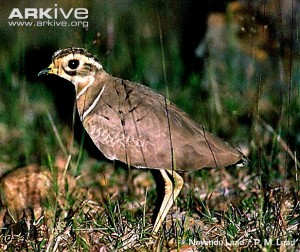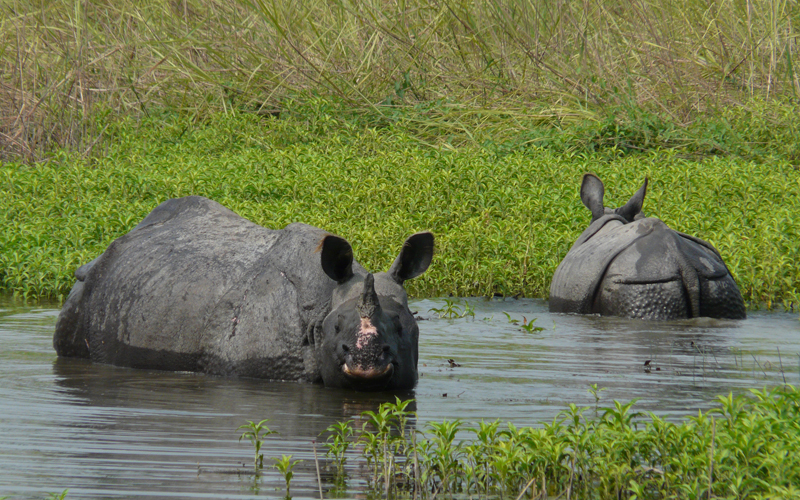 Many people know that India is the only country in the world where half of global population of tiger exists. Few also know about the Asiatic Lion, whose last bastion is again in Sasan Gir National Park in Gujarat, the only place in the world where the beast can be seen in its wild habitat. Yet, when it comes to other species, other than wild cats, that inhabit small, endemic locations, not much is known about them. Not even to conservationists.
Many people know that India is the only country in the world where half of global population of tiger exists. Few also know about the Asiatic Lion, whose last bastion is again in Sasan Gir National Park in Gujarat, the only place in the world where the beast can be seen in its wild habitat. Yet, when it comes to other species, other than wild cats, that inhabit small, endemic locations, not much is known about them. Not even to conservationists.
Such is the case of the bird called Jerdon’s Courser. It is extremely rare, found only in a small part of Andhra Pradesh. Despite being listed as critically endangered by IUCN, there is little that is known about the Jerdon’s Courser. It seems the idiom “Out of sight is out of mind” holds perfectly true for this shy bird. Because the bird is nocturnal and not very keen to publicize its presence, only a handful of people have attempted to know more about this bird that is one of the fifty rarest birds of the world. It was last seen in 2009 and while researchers from Bombay Natural Histroy Society (BNHS) try gather more information about Jerdon’s courser, here is what we do know about it,
Scientific Name – Rhinoptilus bitorquatus
IUCN Red List status – Critically Endangered (CR)
From where does the Jerdon’s Courser get its name?
 The bird was first discovered by Brtish ornithologist and surgeon Thomas Jerdon in 1848. Posted as the Civil Surgeon of Nellore, Jerdon got friendly with the Yanadi Tribes of the area and from them obtained information on local names of birds of the area. The Jerdon’s courser is known as Kalvi Koli in Telugu the regional language and that is because the bush under which the birds are found are called kalvi. But because it was Thomas Jerdon who revealed the existence of the bird to the world as an honor to the discoverer the bird has been named as Jerdon’s Courser.
The bird was first discovered by Brtish ornithologist and surgeon Thomas Jerdon in 1848. Posted as the Civil Surgeon of Nellore, Jerdon got friendly with the Yanadi Tribes of the area and from them obtained information on local names of birds of the area. The Jerdon’s courser is known as Kalvi Koli in Telugu the regional language and that is because the bush under which the birds are found are called kalvi. But because it was Thomas Jerdon who revealed the existence of the bird to the world as an honor to the discoverer the bird has been named as Jerdon’s Courser.
Thomas Jerdon was in fact responsible for discovery of many bird species in India. He is also the man who wrote the epic 3 volume book titled “Birds of India”. Here is an excerpt from his book where he mentions the shy, nocturnal Courser. He calls it the Plover,
“…This remarkable Plover has hitherto, I believe, only been procured by myself, from the hilly country above the Eastern Ghats, of Nellore, and in Cuddapah. It frequents rocky and undulating ground with thin forest jungle, and is found in small parties, not very noisy, but occasionally uttering a plaintive cry. I believe it to be a permanent resident. It is an almost unique instance of a species of Plover having such an extremely limited geographical distribution ; and I imagine that hereafter it will be found spread through many parts of the Balaghat district and Mysore. Blyth writes me that Hemerodromus cinctiis, recently figured in the Ibis, vol. v., is certainly of the same genus as ‘this bird. It appears to be the young of one of the other African species…”
Where is the bird found?
It has a very limited habitat, in southern Andhra Pradesh. Fom the Godaveri river valley near Sironcha and Bhadrachalam, and from the Cuddapah and Anantapur areas in the valley of the Pennar river. Jerdon did think that the bird had a much wider range than this and it even was present in parts of Madhya Pradesh, but at present it remains known only from the vicinity of the Lankamalai, Velikonda and Palakonda ranges in the Pennar valley, Cuddapah district, Andhra Pradesh.
Wasn’t the bird extinct?
After its initial discovery in 1848, it was again seen in 1871 and in 1900. After that for many years no one could spot any Jerdon’s courser for a long time and therefore scientists thought that the bird had become extinct. But in 1986 Bharat Bhushan a keen ornithologist saw the bird at Lankamalai which was then declared a sanctuary. But things are not looking good for the bird as yet again the last sighting was almost 2 years back in 2009 by a research with BNHS Rahul Chavan.
What does a Jerdon’s Courser look like?
A small bird with, two brown breast-bands. Has shortish, black-tipped yellow bill, mostly blackish crown, broad buffish body and orange-chestnut throat patch.
What is the present population status?
Because it has been very difficult to observe the bird, the populations of Jerdon’s courser are an extimate between 2 to 200. With camera trapping and other methods introduced to help sight the bird, hopefully more knowledge about its habits, population, breeding etc. will be known.
What is the bird’s natural habitat?
Jerdon’s courser prefers to live in scrub forests. The preferred habitat is apparently a “thin strip” of scrub forest between denser forests and grazed or cultivated area. Experts observed in Sri Lankamaleshwara Wildlife Sanctuary the sightings were close to small waterbodies in undulating grasslands with thin thorny scrub.
What are the threats to the species?
The courser has a small declining population in a very specific part of Andhra Pradesh. When the state proposed the building of the Somasilla dam, 57 villages were relocated in the very area in Lankamalai where the Jerdon’s courser lived. Subsequently, the dependence of these relocated villages on the forest for fodder, timber etc. and the clearing of land for agricultural purpose are posing a serious threat to the extistence of the courser. In addition excessive quarrying too was posing threat to the habitat.
Any conservation measures taken?
Some of the conservation efforts taken are,
- The Lankamalai (500 km2) and the Veliconda hill range (1,300 km2) areas have been declared as wildlife sanctuaries.
- Andhra Pradesh government realigned the course of the Telagu-Ganga canal, which would otherwise have passed through crucial habitat in Veliconda Sanctuary.
- The central government recently added the species to its priority list of animals needing protection.
- Locals in the area, especially the Yanaadi tribes have been encouraged to take interest in the protection and inform officials whever they can sight a bird.
- BNHS has been conducting field research on Jerdon’s Courser for the past years to help conserve the species, in collaboration with UK-based Royal Society for the Protection of Birds (RSPB), Andhra Pradesh Forest Department, University of Cambridge and University of Reading, funded by the Darwin Initiative.
-

Microchip with Jerdon's Courser call To help aid with the sighting of the bird, an Ohio based toy company came up with a unique idea of a microchip which had the call of the Jerdon’s courser recorded. A 100 of these microchips were given to BNHS in hopes that someone who had heard a similar sound in the forest could confirm the sighting of the bird or pinpoint at a location.
Related Stories:
Government makes effort to Save the Jerdon’s Courser
Poor Genetic Diversity spelling Doom for Great Indian Bustards
Image of bird courtesy: arkive
Other images: wikimedia commons






One thought on “Jerdon’s Courser: A Precious Rarity”